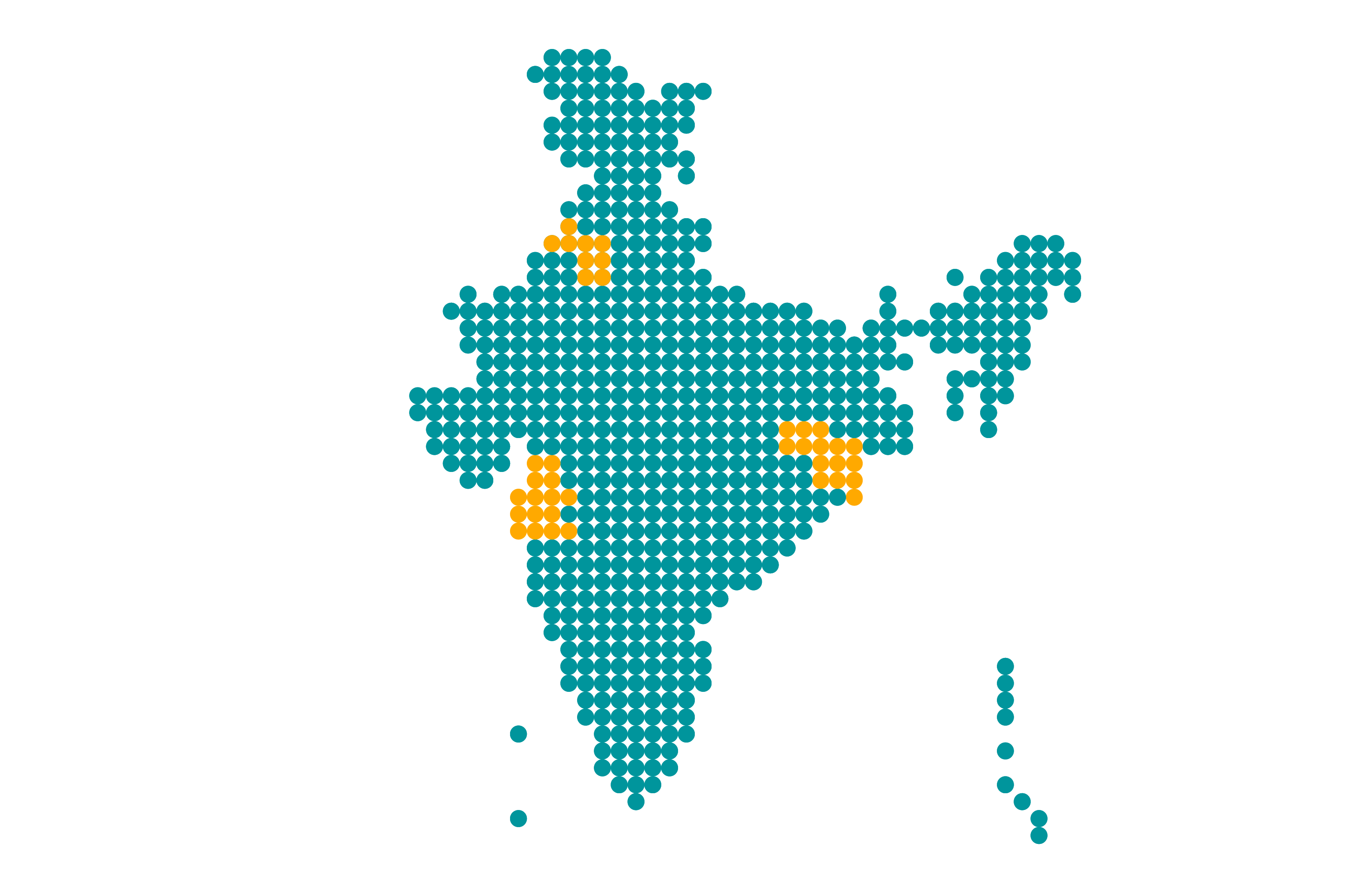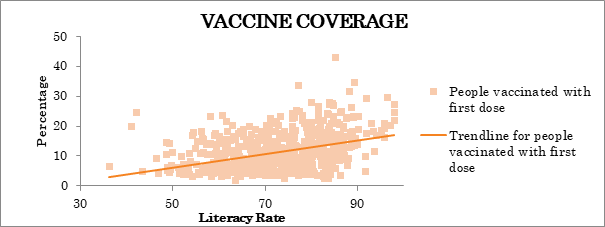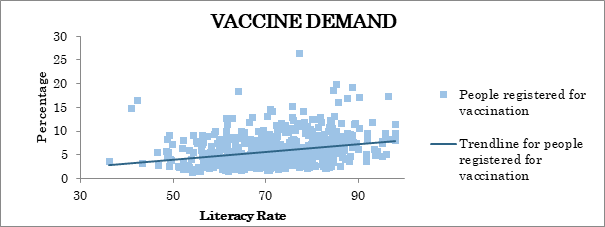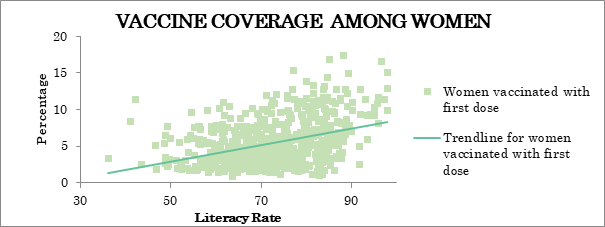
Demand for vaccination, and access to it, is uneven across India. This article presents explanations for this variation. We find a positive correlation between literacy and the first dose vaccination, demand for vaccines, as also vaccine coverage among women.
The demand for vaccination, as also the access to it, is uneven and sluggish across different regions of India. Reasons for this patchy progress need to be investigated urgently if universal vaccination is to be achieved within a stipulated time limit. For now, such inquiries almost entirely comprise discussions on the roles of various types of literacies as enablers and impediments to an appropriate Covid-19 response—including vaccine literacy, health literacy and digital literacy. Regrettably, however, such discussions fall short of drawing links between the response efficacy of different populations to Covid-19 and the most literal form of literacy, defined as the ability to read and write.
Given India’s 287 million illiterate people (Census 2011), mapping the connection between illiteracy and the ravages of Covid-19 is critical to directing our policies towards containing the pandemic. Extant empirical research studies indicate that female literacy does indeed lead to improved health indicators in families.
Mapping links between vaccination coverage and literacy in India
For this article we use vaccination data from January 16, 2021 to July 20, 2021 scraped from the CoWIN website. All other data used have been taken from the Census 2011 and projected for 2021. Then, we merge district level CoWIN information on vaccination with district wise demographic details available in the census. All the parameters used in this article are normalised with populations of respective districts. Description of the data extracted from CoWIN and Census 2011 is given in Table 1.
Table 1: Description of data from the CoWIN website and Census 2011
| DATA | DESCRIPTION |
|---|---|
Vaccine coverage |
|
Vaccine demand |
|
Vaccine coverage among women |
|
Literacy rate |
|
Our preliminary investigation of the data so derived showed that Kerala, Delhi and Gujarat were, till July 20, 2021, the best performing states in terms of vaccinating their populations with at least one Covid-19 vaccine dosage. Bihar, Uttar Pradesh and Jharkhand lagged. We further delve into the explanations for this variation from a demand perspective.
Literacy and vaccine coverage
We find a high positive correlation between literacy and the first dose vaccination coverage (Refer to Figure 1). Also, our econometric analysis shows that vaccination coverage is significantly dependant on literacy levels, even when we take availability of vaccination centres into consideration and control our calculations for this. This means that districts with high literacy rates are more likely to have high vaccination coverage. For example, the Pathanamthitta district of Kerala with a literacy rate of 97 per cent has vaccinated 50 per cent of its population. Whereas, the Nuh district of Haryana with literacy rate of 54 per cent has been able to administer first doses to only 10 per cent of its population.
Figure 1: Link between literacy rate and vaccine coverage

Source: Authors’ calculations
Literacy and vaccine demand
Not just overall vaccine coverage, our analysis finds that even vaccine demand is positively correlated with literacy rate (Refer to Figure 2). We arrive at this finding by using the proportion of people who registered for vaccination on the CoWIN website as a proxy for vaccine demand. Here too, and expectedly so, Kerala’s Pathanamthitta tops in vaccine demand and Nuh district of Haryana secures the last spot.
State-wise result shows Gujarat with a 78 per cent literacy rate topping the list with six per cent of its population having registered for vaccination. Bihar with the country’s lowest literacy rate at 62 per cent, has only two per cent of its population registering for vaccination on CoWIN.
Figure 2: Link between literacy rate and vaccine demand

Source: Authors’ calculations
Vaccine coverage among women and literacy
The positive co-relation between literacy and vaccine coverage extends to include greater vaccine coverage among women in regions with better literacy rates (Refer to Figure 3). For instance, significantly higher participation by women in the ongoing vaccination drive is observed in Kerala where 1206 women are getting vaccinated against 1067 men on an average. Whereas vaccination of women is lowest in Uttar Pradesh, where 741 women are getting vaccinated against 1000 men on an average. Literacy is higher in Kerala at 94 per cent than in Uttar Pradesh at 68 per cent. District wise results show that 23 per cent women have been vaccinated till June 24, 2021 in Pathanamthitta district of Kerala as opposed to Sambhal district of Uttar Pradesh where only one per cent women have been administered the first dose. The literacy rates in Pathanamthitta and Sambhal are 97 per cent and 57 per cent respectively.
Figure 3: Link between literacy rate and vaccine coverage among women

Source: Authors’ calculations
Conclusion
The Covid-19 pandemic is not going away soon and may even return in more distressing and disruptive versions in the future. To combat these possibilities effectively, we must use our immediate learnings for future readiness. Keeping in mind India’s large volume of illiterates, we should recognise the vulnerability of this considerable population in combatting a pandemic such as the one that has us in its throes presently. We should acknowledge the unpreparedness arising from a very basic form of illiteracy, and devise strategies to correct this condition. With more adults functionally literate, India will be significantly more resilient against pandemics and pandemic-like situations.
(Acknowledgement: An extended version of this article has been published in the Economic and Political Weekly)
Arijit Das (adas@idfresearch.org) and Soma Wadhwa are Fellows, and Tanya Bansal is Research Assistant at the India Development Foundation.
Reference
Achom, Debanish (July 2021): “Vaccination shortfall: India's 5 best and worst states,” NDTV. Retrieved from https://www.ndtv.com/india-news/coronavirus-vaccination-shortfall-indias-5-best-and-worst-states-2483092
Alexander Ashok (July 2018): “Educating girls can improve India’s health outcomes,” Mint. Retrieved from https://www.livemint.com/Opinion/6EvW7MxzLpcdsk2aifu59N/Educating-girls-can-improve-Indias-health-outcomes.html
Basu, Mohana (July 2021): “Bihar & UP worst performers on state Covid vaccination list, only 10% have got 1st dose,” The Print. Retrieved from https://theprint.in/health/bihar-up-worst-performers-on-state-%E2%80%8Bcovid-vaccination-list-only-10-have-got-1st-dose/684464/
Berkman, Nancy D., Stacey L. Sheridan, Katrina E. Donahue, David J. Halpern, and Karen Crotty (2011): “Low health literacy and health outcomes: an updated systematic review,” Annals of internal medicine, 155(2), 97-107.
Choudhury, Saheli Roy (June 2021): “India’s ambitious vaccine targets alone will not help immunize its massive population,” CNBC. Retrieved from https://www.cnbc.com/2021/06/14/india-covid-crisis-making-vaccines-readily-available-is-a-challenge.html"
Creswell, John W (2013): Steps in conducting a scholarly mixed methods study, UBER speaker series, University of Nebraska, Lincoln, https://digitalcommons.unl.edu/dberspeakers/48/
Dewalt, DA, Berkman, ND, Sheridan, S, Lohr, KN, and Pignone, MP (2004): “Literacy and health outcomes: a systematic review of the literature,” Journal of general internal medicine, 19(12), 1228–1239.
Jacobson, Terry A., Donna M. Thomas, Felicia James Morton, Gardiner Offutt, Jennifer Shevlin, and Susan Ray (1999): “Use of a low-literacy patient education tool to enhance pneumococcal vaccination rates: a randomized controlled trial,” Jama, 282(7), 646-650.
Kumar, Rajiv (June 2021): “Giving their best shot: Goa, Sikkim and Himachal top 3 states by vaccination rate,” News 18. Retrieved from https://www.news18.com/news/india/giving-their-best-shot-goa-sikkim-and-himachal-top-3-states-by-vaccination-rate-3860210.html
Registrar General and Census Commissioner of India, Ministry of Home Affairs, Government of India (2011): “Census of India,” New Delhi
Sharma, Samrat (May 2021): “Wastage, shortages slow down India’s vaccine drive at first shot,” India Today. Retrieved from https://www.indiatoday.in/diu/story/wastage-shortages-slow-down-india-s-vaccine-drive-at-first-shot-1799235-2021-05-05
The views expressed in the articles published on this microsite are those of their authors. The articles are not peer reviewed. While we have made sincere attempts to verify the facts presented in the articles published here, we do not vouch for their veracity or accuracy.